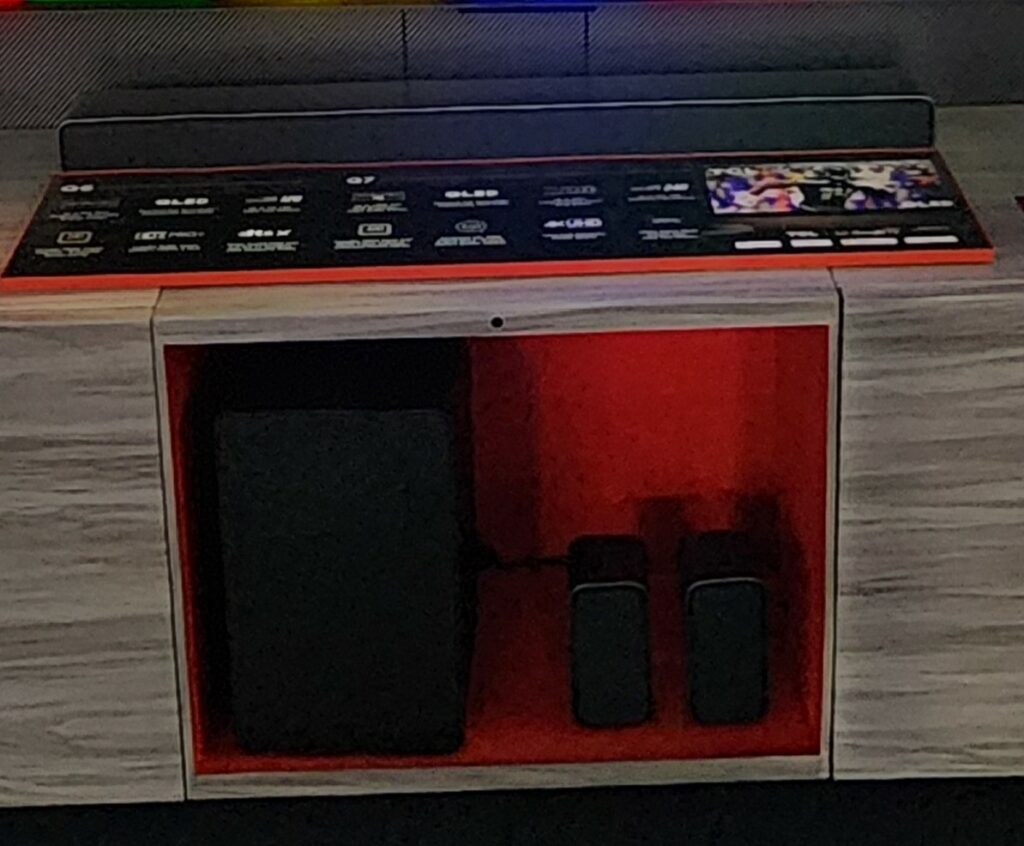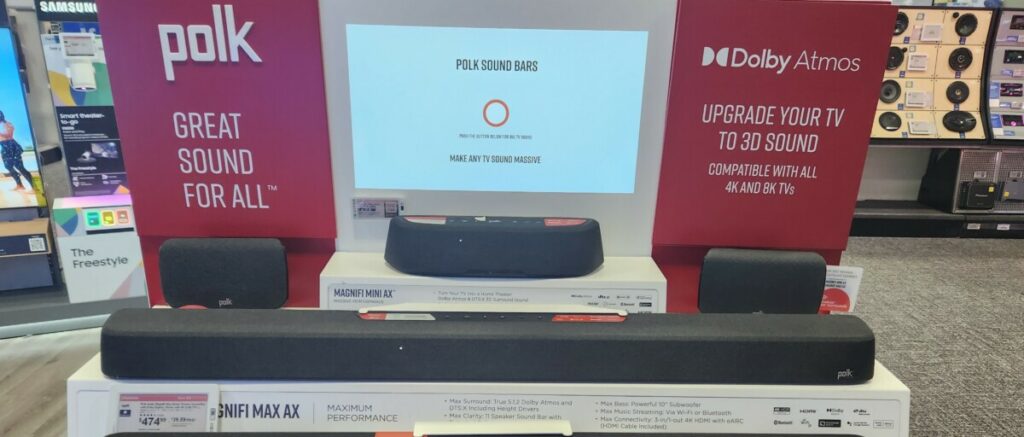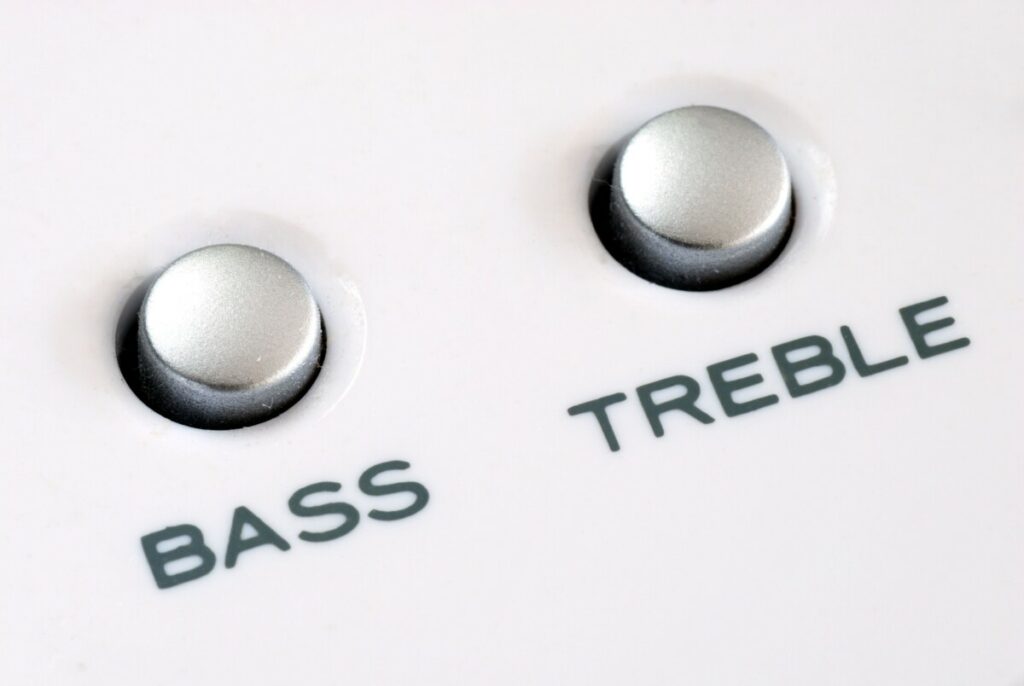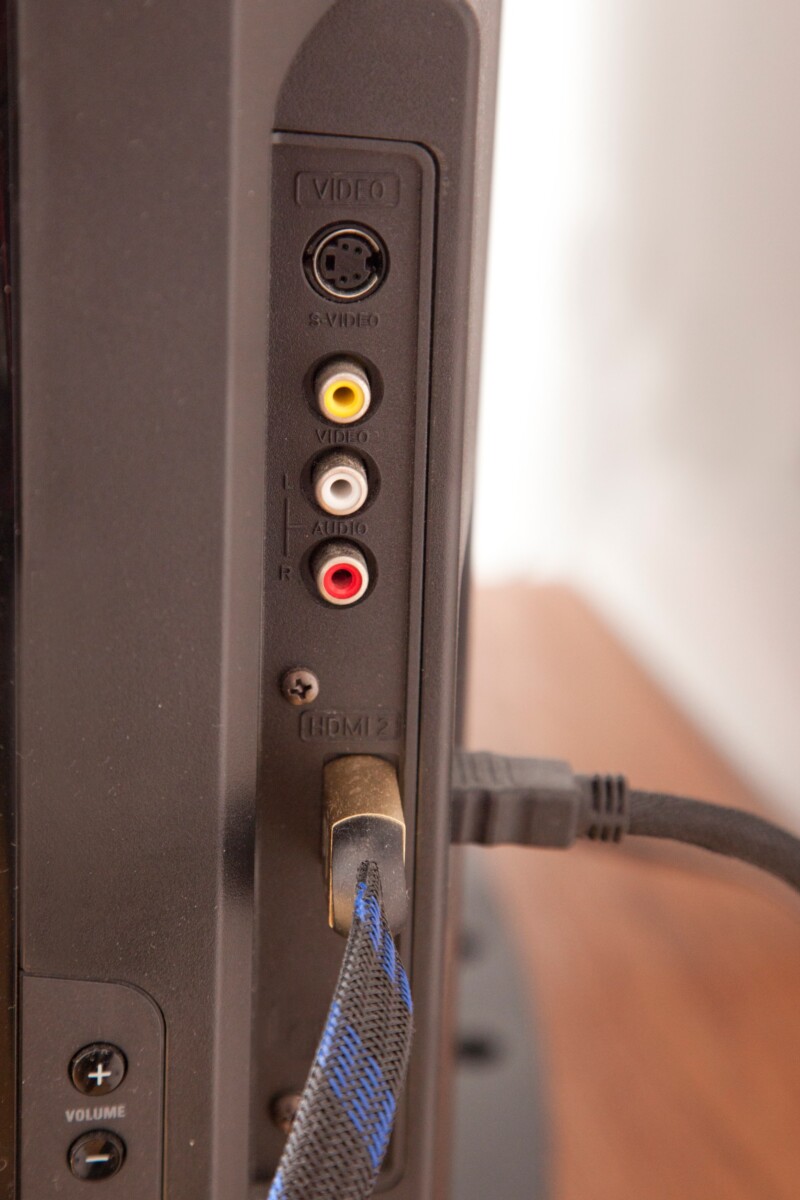As an Amazon Associate I earn from qualifying purchases
In a world where home entertainment setups are becoming increasingly sophisticated, the question arises: can you elevate your audio experience by connecting two soundbars to a single TV?
I will go into detail on if you should do this, how to connect two soundbars to the tv as well as alternative options you can consider instead such as adding rear speakers and a subwoofer.
Exploring the Possibility: Can You Connect Two Soundbars to a Single TV?

Can you hook two soundbars to one TV?
The answer isn’t a straightforward yes or no. While technically feasible, hooking up two soundbars to one TV requires certain considerations, such as input availability and the soundbars’ compatibility.
It’s essential to explore the intricacies involved in syncing two soundbars to avoid technical conflicts.
However, I do recommend investing in a subwoofer or rear speakers instead of trying to hook up two soundbars to a TV.
I will seek to explain this further in this blog post.
Initial Considerations: Understanding the Challenges of Dual Soundbar Setups
One must consider whether you can truly connect two soundbars to a singular television and how this impacts audio synchronization.
- Typically, connecting two soundbars involves more than merely handling multiple cables; it’s a test of compatibility and audio distribution.
- The feasibility of dual soundbar setups relies highly on the TV’s available outputs and the soundbars’ input options.
- Additionally, the question of whether the two soundbars can operate in tandem without causing audio delays or interference is crucial.
Therefore, these initial considerations set the stage for the complexity that comes with attempting to connect two soundbars – a task that demands thoughtful planning and, at times, creative troubleshooting to overcome potential obstacles.
Consider adding a subwoofer and rear speakers instead of connecting two soundbars

While the idea of connecting two soundbars to one TV might seem appealing for enhancing your home theater experience, it’s worth considering alternative audio solutions.
Adding a subwoofer and rear speakers, for instance, will provide a more immersive sound system than deploying multiple soundbars.
Subwoofers deliver profound bass frequencies that soundbars cannot produce, giving depth to your audio, while rear speakers ensure a richer surround sound effect.
Rather than attempting to sync two soundbars—which can introduce a host of complexities and potentially inconsistent audio output—investing in a quality subwoofer and rear speakers can significantly elevate your home theater setup.
This approach also avoids the redundancy and aesthetic complications of having two soundbar units.
For an optimal acoustic ambiance, extending your sound system with these speakers is usually more effective than trying to connect two soundbars to achieve a fuller sound profile.
Techniques to Connect Two Soundbars

Initially, one must consider whether their TV supports multiple audio outputs, as this is crucial for attempting to connect two soundbars.
If possible, the most straightforward method is using available audio outputs to connect each soundbar.
Techniques involve using an optical splitter for TVs with a single optical port or exploiting multiple HDMI ARC ports.
Here are two HDMI Splitters you can choose from if you don’t already have one.
J-Tech Digital Optical Splitter
- Support 5.1 channels output up 15 ft.
- Support Dolby Digital & DTS 5.1; Support PCM Stereo 32kHz, 44.1kHz, 48kHz and 96kHz; plug & play
- Over-voltage protection can prevent the damage caused by connecting unmatched power adapter to the machine
- Free lifetime technical support from the manufacture and free 1 Year Manufacturer Warranty from J-Tech Digital.
LiNKFOR Digital Optical Audio 1x3 Splitter
- 【Support Audio Format】Support Digital 5.1CH Dolby-AC3/DTS/PCM/LPCM2.0 32kHz,44.1kHz,48kHz and 96kHz
- 【Long distance signal transmission】 Used optical fiber cable loss less the 0.2Db/m, Output distance is up to 25m/80ft.
- 【Voltage Protection】Over-voltage protection can prevent the damage caused by connecting unmatched power adapter to the machine.
- 【High-grade Aluminum Alloy Design】 Overall Shielding without Signal Interference, Ensure high-quality audio signal to send
However, it’s essential to manage expectations, as not all TVs facilitate this kind of setup, and audio synchronization could become an issue.
Hence, while learning how to connect two soundbars, it’s vital to also understand the intricacies of configuring settings to ensure unified output.
To optimize this dual soundbar setup, consider employing methods like soundbar pairing via Bluetooth if the soundbars support it, or utilizing a specialized audio mixer for a cohesive audio experience.
How to Connect Two Soundbars Using HDMI: Navigating the Cables and Ports

When attempting to connect two soundbars to one television, utilizing HDMI is a common and effective method.
The process requires an understanding of the available HDMI connections on your TV and soundbars.
More premium soundbars utilize HDMI eARC for Dolby Atmos content for example, you will need a 4k HDMI Cable for those types of soundbars.
To successfully navigate the cables and ports, first ensure you have two compatible HDMI cables.
Connecting two soundbars using HDMI may seem daunting, but it typically involves linking one soundbar to the TV’s HDMI ARC port while using an HDMI switcher or splitter for the second.
The goal is to maintain audio synchronicity between the two soundbars without compromising sound quality.
Although this setup is unconventional, with the right HDMI cable equipment and a careful approach to navigating the cables and ports, you can achieve a unique audio arrangement for your entertainment system.
Dual Connection with Audio Cables: Selecting the Proper Cable for Your Soundbars
Achieving a dual connection with audio cables requires meticulous attention, especially when connecting both soundbars to your television.
When selecting the proper cable for this task, understanding the nuances of audio cables is imperative.
Typical cables used for such connections include left and right RCA cables, which can effectively transmit audio signals to your soundbars.
In a dual setup, it’s essential to use cables that can handle the audio output without degradation.
Using high-quality RCA cables for the connection can assure that the integrity of the sound is preserved.
- When you’ve got two soundbars, ensuring that the audio cables are of sufficient length and build is key to a seamless audio experience.
- Carefully connecting these cables to the dedicated ports on both soundbars will ensure the desired stereo effect.
The cable should not only fit securely but also match the input capabilities of the soundbars. Remember, a reliable dual audio setup rests on the shoulders of the connections you make.
Addressing Sound Quality and Power Requirements

Addressing sound quality when connecting multiple soundbars to a single TV is paramount as it can affect the overall audio experience.
Ensuring the soundbars are properly synced is necessary to maintain the integrity of the sound output, avoiding echoes or delays that could degrade sound quality.
Power requirements are also critical, with each soundbar needing adequate power to function without overloading the TV’s outputs or the home’s electrical system.
This is important as you don’t want to overload the outlet or have your equipment damaged due to a power surge.
Sound clarity could be compromised if power demands aren’t met.
It’s not just about providing power but also about harmonizing the sound from the two soundbars, so they enhance rather than interfere with each other.
Can You Connect Two Soundbars for Enhanced Sound Supply?
The answer is yes; you can connect two soundbars to to a tv enhance the sound supply.
However, if you’re aiming for surround sound, integrating a subwoofer and rear speakers will be more effective than trying to connect two soundbars.
If you decide to proceed with two soundbars, utilizing HDMI or the appropriate audio cables is crucial. Remember though, not every TV will support this configuration, and the integration process can be intricate.
Positioning and Powering Multiple Soundbars
When exploring the innovative concept of connecting two soundbars to one TV, understanding the nuances of positioning and powering is essential.
It’s crucial to address the power requirements of a dual soundbar setup, as inadequate powering can lead to subpar performance.
I recommend using a surge protector and plugging both your soundbars into it. Here is the one I use.
- Powerful Home Power Strip: With a 2100-joule rating, this surge protector absorbs a high amount of energy to protect your home appliances and prolong unit life
- Surge Protector Power Outlet: Protects your coaxial cables from power surges and spikes to protect your cable, phone line and more
- Convenient USB Charging: This surge protector has 2 USB ports that deliver a 2.1 amp total output for charging mobile phones and more
- Power Outlet with Protection: The EMI/RFI noise filter protects against electromagnetic and radio frequency interference that can cause memory loss
- Enhance Your Home Entertainment System: Rocketfish makes cutting-edge products to improve the performance of your home entertainment system
I also recommend investing in some soundbar wires as having two soundbars connecting to a TV can look unpleasing aesthetically.
Optimizing Your TV’s Audio with Two Soundbars

Hooking up two soundbars to a single TV may seem unconventional, but when executed correctly, this setup can *enhance* the overall sound landscape.
Important: To truly optimize your TV’s audio, it’s crucial to delve into the soundbar settings and adjust them for harmonious functioning.
Begin by ensuring both soundbars are synced—thwarting any delays that can mar the listening experience.
Tweaking equalizer presets to complement each sound profile will elevate the audio quality.
Balancing volume levels to prevent one soundbar from overpowering another is key for a cohesive sound output. Also, consider employing a unified control system to streamline the operation of both devices.
Ensuring Quality Sound: Tips for When You Connect Two Soundbars
High-quality cables are crucial—they not only ensure a stable connection but also preserve sound clarity, warding off any electrical interference.
Remember, the objective is to have both soundbars work in tandem to amplify your listening experience.
To do so, consider factors such as room acoustics, soundbar placement, and calibration to achieve optimal sound quality without latency issues.
Concluding Insights on Multiple Soundbar Connections
In concluding insights on multiple soundbar connections, it’s essential to reflect on the feasibility and the practicality of such setups.
When you connect two soundbars to a single TV, there are myriad factors to consider, from audio synchronization to input management.
These insights into multiple soundbar connections suggest that while it’s technically possible to connect two soundbars, doing so isn’t always straightforward.
I think it is a better option to add rear speakers and a subwoofer than to connect two soundbars. Personally, I would never connect two soundbars to my TV.
Again. I’d recommend reading my article on why rear speakers are optimal for a soundbar.
Assessing the Merits: Are Two Soundbars Truly Better Than One?
Connecting two soundbars to one TV often seems like an upgrade to your home audio system, but it’s critical to assess whether it’s truly the best step for enhancing your sound experience.
Doubling up on soundbars doesn’t guarantee an improved audio field; in fact, it could complicate syncing and lead to an unbalanced soundstage.
When you’re asking, “Can you connect two soundbars?” the answer isn’t just about the possibility but the practicality.
The quality of the soundbars, their compatibility with one another, and the acoustics of your room are paramount considerations.
I don’t recommend connecting two soundbars because it rarely results in the cohesive, immersive audio environment you might expect.
Each soundbar is designed to deliver a complete audio experience; putting two together can create interference and diminish the overall clarity.
Instead, adding rear speakers and a subwoofer to your setup is a much better choice for those seeking a true surround sound experience.
With rear speakers, you achieve genuine audio depth, and the subwoofer adds powerful bass that a soundbar alone, or even two, can’t match.
The intricacies of placing and connecting multiple soundbars—taking into account HDMI inputs, Bluetooth connectivity, audio outputs, and the potential for an audio delay or echo—highlight why this setup is less than ideal.
Ultimately, a single, high-quality soundbar supplemented with additional speakers and a subwoofer offers a simpler connection process and delivers the superior audio quality most TV viewers desire.





